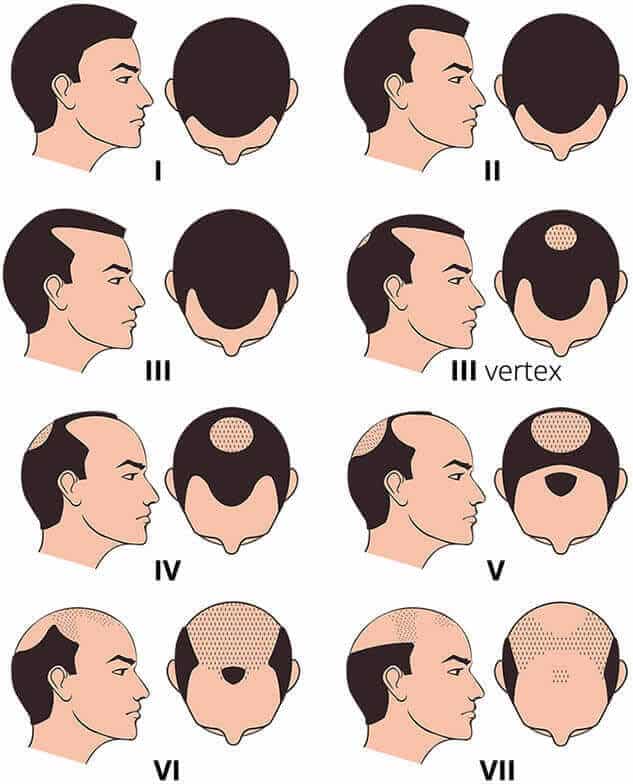
Norwood Scale Male Pattern
Hair loss can be a challenging experience, impacting both physical appearance and self-confidence. However, understanding your hair loss stage is key to finding effective solutions. In this blog post, we’ll explore the Norwood Scale, a valuable tool that helps individuals identify their stage of hair loss and guides them towards appropriate hair transplant solutions.
What is the Norwood Scale?
The Norwood Scale, named after Dr. O’Tar Norwood, is a widely used classification system for male pattern baldness. It categorizes the stages of hair loss in men, ranging from minimal to advanced balding. By assessing various factors such as hairline recession and balding patterns, the Norwood Scale provides a comprehensive overview of an individual’s hair loss stage.
Understanding Your Hair Loss Stage
Knowing your hair loss stage is crucial for determining the most suitable hair transplant solution. The Norwood Scale helps individuals recognize where they fall on the spectrum of hair loss, whether it’s early-stage thinning or more advanced balding. By accurately identifying your hair loss stage, you can make informed decisions about treatment options and set realistic expectations for results.

How the Norwood Scale Guides Hair Transplant Solutions?
Hair transplant procedures are meticulously crafted to address the distinct stages of hair loss and the unique objectives of each individual. At the heart of this customization lies the Norwood Scale, a widely-used tool that serves as a navigational compass for hair transplant surgeons. By meticulously assessing the pattern and severity of hair loss indicated by the Norwood Scale, surgeons can curate treatment plans that precisely cater to the needs of their patients.
For those in the early stages of hair loss, the focus may revolve around preserving existing hair and reinstating a natural-looking hairline. This could involve strategic interventions such as targeted graft placement and density restoration techniques. On the other hand, individuals grappling with more advanced stages of hair loss may require more extensive restoration efforts. In such cases, larger grafts and comprehensive coverage strategies are often employed to achieve optimal results.
By leveraging the insights provided by the Norwood Scale, surgeons can navigate the complexities of hair loss with precision and finesse. This allows for the development of highly personalized treatment regimens that not only address current concerns but also lay the foundation for long-term hair restoration success. Whether it’s reclaiming confidence or revitalizing one’s appearance, the Norwood Scale serves as an indispensable tool in the journey towards achieving the desired hair transplant outcomes.
Choosing the Right Hair Transplant Procedure
In the realm of hair restoration, the landscape has evolved significantly, offering a diverse array of options for those seeking to address hair loss concerns. Among the plethora of techniques available, two prominent approaches stand out: Follicular Unit Transplantation (FUT) and Follicular Unit Extraction (FUE). Each method boasts its own set of advantages and considerations, making the decision-making process a crucial step in the journey towards hair restoration.
At the core of this decision lies the Norwood Scale, a fundamental tool that serves as a guiding beacon for both individuals and surgeons alike. By meticulously assessing factors such as hair density, donor hair availability, and desired outcomes, the Norwood Scale empowers individuals to make informed choices regarding their hair transplant procedure. This invaluable assessment allows for the alignment of the chosen procedure with the individual’s specific hair loss stage, thereby maximizing the likelihood of achieving optimal results.
For those in the earlier stages of hair loss, considerations may lean towards procedures that prioritize the preservation of existing hair and the establishment of a natural-looking hairline. In such cases, techniques like FUE, with its minimally invasive approach and precise graft placement, may offer a compelling solution. Conversely, individuals grappling with more advanced stages of hair loss may find FUT, with its ability to harvest larger quantities of grafts in a single session, to be a more suitable option.
By leveraging the insights provided by the Norwood Scale and aligning them with the intricacies of each individual case, surgeons can tailor treatment plans that not only address current concerns but also pave the way for enduring hair restoration success. This synergy between assessment and execution ensures that each procedure is meticulously crafted to deliver results that exceed expectations and stand the test of time. Ultimately, the journey towards choosing the right hair transplant procedure is as much about understanding one’s unique needs as it is about embracing the transformative potential of modern hair restoration techniques.
Conclusion
In the realm of hair restoration, the Norwood Scale stands as a cornerstone, offering invaluable insights into the progression and severity of male pattern baldness. As individuals navigate the complexities of hair loss, understanding their unique position on the Norwood Scale can serve as a powerful catalyst for informed decision-making and effective treatment strategies.
At its core, the Norwood Scale serves as more than just a diagnostic tool; it represents a beacon of hope for those grappling with hair loss concerns. By comprehensively assessing factors such as hairline recession, temple recession, and crown balding, the Norwood Scale provides a comprehensive overview of an individual’s hair loss stage, empowering them to take proactive steps towards restoration.
Armed with this knowledge, individuals can embark on a journey of exploration and discovery, seeking guidance from qualified hair transplant surgeons who specialize in interpreting and leveraging the insights offered by the Norwood Scale. Through personalized consultations and meticulous assessments, these experts collaborate with patients to craft tailored treatment plans that address their unique needs and aspirations.
By embracing the guidance of the Norwood Scale and partnering with skilled professionals, individuals can unlock a world of possibilities in the realm of hair restoration. From Follicular Unit Transplantation (FUT) to Follicular Unit Extraction (FUE) and beyond, the options abound, each offering its own blend of advantages and considerations.
Yet, amidst the diversity of approaches, one truth remains constant: the Norwood Scale serves as a compass, guiding individuals towards solutions that not only restore their hair but also reignite their confidence and sense of self. Don’t let hair loss hold you back from living life to the fullest. Embrace the wisdom of the Norwood Scale, and take the first step towards a future defined by a fuller, thicker head of hair and newfound confidence.
Schedule a Free Consultation
Ready to explore hair transplant solutions tailored to your hair loss stage? Schedule a consultation with Get Hair today and discover how the Norwood Scale can guide your journey to hair restoration.
Simply schedule a free consultation with us to learn more about our hair transplant services and to begin the process.
To get more information about our treatments and hair transplant solutions, reach out to us.
References:
Norwood OT. Male pattern baldness: classification and incidence. South Med J. 1975;68(11):1359-1365.
Hamilton JB. Patterned loss of hair in man; types and incidence. Ann N Y Acad Sci. 1951;53(3):708-728.
Bernstein RM, Rassman WR. The aesthetics of follicular transplantation. Dermatol Surg. 1997;23(9):785-799.
Unger WP, Unger RH, Wesley CK. The surgical treatment of cicatricial alopecia. Dermatol Ther. 2008;21(5):295-311.
